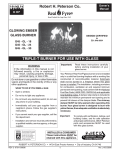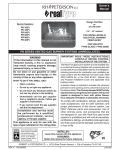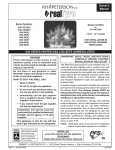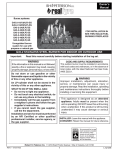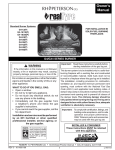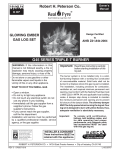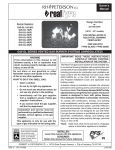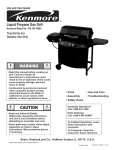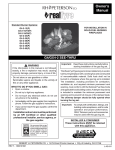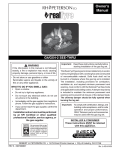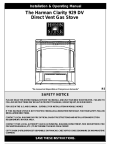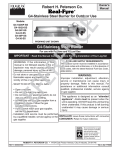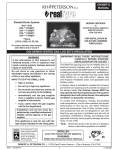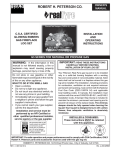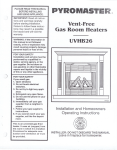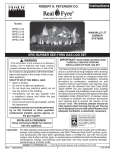Download R.H. Peterson G4 Owner`s manual
Transcript
Owner’s Manual Woodland Oak (WOG4-24) Shown G4/GX4 SERIES BURNER Important: Read these instructions carefully before starting installation of the gas log set. WARNING If the information in this manual is not followed exactly, a fire or explosion may result, causing property damage, personal injury, or loss of life. This burner system is to be installed only in a solid-fuelburning fireplace with a working flue and constructed of noncombustible material. Solid fuels shall not be burned in a fireplace where this gas log set is installed. The installation, including provisions for combustion, ventilation air, and required minimum permanent vent opening, must conform with the National Fuel Gas Code (Z223.1) and applicable local building codes. A damper stop clamp is included to maintain the minimum permanent vent opening and to prevent full closure of the damper blade. The chimney damper should be fully opened when burning the log set. The log set is designed to burn with yellow flames; thus, adequate ventilation is absolutely necessary. Do not store or use gasoline or other flammable vapors and liquids in the vicinity of this or any other appliance. WHAT TO DO IF YOU SMELL GAS: • Open a window. • Do not try to light any appliance. • Do not touch any electrical switch; do not use any phone in the building. • Immediately call the gas supplier from a neighbor’s phone and follow the gas supplier’s instructions. • If you cannot reach the gas supplier, call the fire department. Installation and service must be performed by an NFI Certified or other qualified professional installer, service agency, or the gas supplier. Important: To comply with certification, listings, and building code acceptance, and for safe operation and proper performance, ONLY Peterson parts and accessories may be used with this gas log set. INSTALLER & CONSUMER These instructions MUST be retained with this appliance. We recommend that our gas hearth products be installed and serviced by professionals who are certified in the U.S. by the National Fireplace Institute® (NFI) as NFI Gas Specialists. ROBERT H. PETERSON CO. • 14724 East Proctor Avenue • City of Industry, CA 91746 REV 4 - 0907131103 1 No. L-A2-01309 IMPORTANT - Read This Manual Carefully Before Starting Installation of the Log Set When the log set is burning, the fireplace damper must be fully open. The Peterson RealFyre® gas log set is to be burned only in a fully vented, noncombustible fireplace with damper and chimney free of any obstructions. The fireplace must be designed and approved to burn wood. As with burning natural firewood, the Real-Fyre® log set is designed to burn with yellow, smoky flames. For this reason, it must be adequately vented. The smallest dimension of the chimney flue must be at least 8". If it is smaller, do not use this Real-Fyre® log set. If fumes from the burner emerge into the room when the damper is fully open, creating a smell like a smoldering oil lamp, it indicates that the fireplace draft is defective. Check chimney flue for obstructions. Do not operate the log set until the fireplace draft is corrected. Check with the dealer or installer. Do not use firewood with the gas log set. Some Available Log Styles: Charred Series Charred Oak (CHD) Charred Split (CHS) Charred Royal (CHB) Classic Series Golden Oak (R) Post Oak (PO) Emberwood (E) Royal English Oak (B) Mountain Oak (K) Twisted Pine (C) Designer Series Golden Oak Designer Plus (RDP) Split Oak (S) Split Oak Designer Plus (SDP) Woodland Oak (WO) Designer (EXD) Royal English Oak Designer (BD) Heritage Designer (HD) White Birch (W) Golden Oak Designer (RD6) FOR YOUR SAFETY Do not store or use gasoline or other flammable vapors and liquids in the vicinity of this or any other appliance. TABLE OF CONTENTS PARTS LIST FIREPLACE REQUIREMENTS INSTALLING THE BURNER SYSTEM INSTALLING THE DAMPER CLAMP INSTALLING THE BURNER SYSTEM (Cont.) PLACEMENT OF GRATE AND BURNER CONNECTING THE GAS SUPPLY INSTALLING THE BURNER SYSTEM (Cont.) INSTALLING THE BURNER SYSTEM (Cont.) INSTALLING THE BURNER SYSTEM (Cont.) PLACEMENT OF GRANULES, GLOWING EMBERS AND GRATE GRANULE PLACEMENT GLOWING EMBERS PLACEMENT GRATE REPLACEMENT GAS LOG PLACEMENT DESIGNER AND CLASSIC SERIES LOG PLACEMENT CHARRED SERIES SUPPLEMENTAL INSTRUCTIONS EMBER COALS PLACEMENT CHARRED SERIES LOG PLACEMENT GAS LOG SET OPERATING INSTRUCTIONS LIGHTING INSTRUCTIONS GAS LOG SET OPERATING INSTRUCTIONS (Cont.) MAINTENANCE AND SERVICE MAINTENANCE SERVICE FLAME DESCRIPTION TROUBLESHOOTING THE GAS LOG SET TROUBLESHOOTING THE GAS LOG SET (Cont.) OPTIONAL CONTROLS FOR YOUR REAL-FYRE® BURNER SYSTEM WARRANTY REV 4 - 0907131103 2 3 4 5 5 6 6 6 7 8 9 10 10 10 10 11 11 12 12 12 13 13 14 14 14 14 14 15 16 17 18 No. L-A2-01309 PARTS LIST Before beginning installation, be sure the gas log set is complete by comparing its contents with this PARTS LIST. The RG4-24 set is listed and illustrated. Your parts may differ depending upon the log style and size of the set. Be sure you know the model number and size of your set when ordering replacement or optional parts and accessories. 13 6 4 14 12 3 5 2 11 Sand or vermiculite granules 10 Glowing Embers 1 7 8 Note: 24" Golden Oak log set depicted here as an example. Item No. 1. 2. 3. 4. 5. 6. 7. or 8. 9. 10. 11. or 12. or 13. or Part No. Description RL-24BF RL-20BR RL-15TL RL-15TR RL-9TL RL-9TR SC-2-2 SC-3-2 DC-1 CK-4-12 EM-1 CS-12 LF-15 AB-2-29 AM-2-50 SD-24 SX-24 Golden Oak front bottom log 24" Golden Oak rear bottom log 20" Golden Oak top log 15" Golden Oak top log 15" Golden Oak top log 9" Golden Oak top log 9" Stabilizer clips G4 (2) Stabilizer clips GX4 (2) Damper clamp Connector kit Glowing Embers (2) Select sand granules (natural) Vermiculite granules (propane) Fuel injector (natural) Air mixer (propane) Fireplace grate 24" Heavy-duty fireplace grate (GX4 log sets) Burner pan, glowing embers 24" 14. GG-24 9 Large hearth elbow (to gas supply) 10a Aluminum tubing 10b Small brass connector elbow (to burner) 10c Note: Values in bold change with burner size, model, and log set. *For propane units, add a "P" to the end of the part number. Replacement parts can be ordered from your local REV 4 - 0907131103 3 Real-Fyre® CK-4 Connector kit dealer. No. L-A2-01309 BEFORE YOU BEGIN - IMPORTANT INFORMATION Before you begin, review the below information and safeguards about the installation and operation of the Real-Fyre® gas log set. Check to be sure the fireplace meets venting and construction requirements for the installation of the RealFyre® gas log set (see FIREPLACE REQUIREMENTS section, below). Check to be sure the gas log set is designed for the proper gas type. Real-Fyre® log sets are designed for use with natural gas unless clearly labeled for propane gas. Sets designed for use with propane gas must be installed with a safety pilot system. Never use propane gas in a log set designed for natural gas or natural gas in a log set designed for use with propane gas. Be sure the gas log set is properly sized for the fireplace. Improper sizing may negatively impact the proper drafting of the fireplace. Additionally, too large a log set will adversely affect the burn and hamper the proper operation of the control system. Too small a log set will diminish the beauty of the hearth setting. Fig. 4-1 illustrates the critical dimensions of the firebox. This gas log set must be installed by an NFI Certified or other qualified professional installer. The installation, including provisions for combustion and ventilation air, must conform with local codes, or, in the absence of local codes, with the latest edition of the National Fuel Gas Code, ANSI Z223-1 and NFPA54. Important: To comply with certification, listings and building code acceptances, and for, safe operation and proper performance of this log set, use ONLY Peterson Real-Fyre® parts and accessories. Use of other controls, parts, and accessories that are not designed for use with Real-Fyre® gas log sets is prohibited and will void all warranties, certifications, listings, and building code approvals, and may cause property damage, personal injury, or loss of life. Fireplace dimensions Fig. 4-1 Rear width HEIGHT H eight DEPTH Depth F r ONT ont FR w iWIDTH d t h oOPENING pening † Add 4" to front opening width if the burner is to be installed with a pilot kit. Double this measurement to center burner. ‡ The chimney vent opening provided is based upon a required minimum chimney height of 15 feet. Note: It is recommended that complete firebox dimensions (front width, depth, back wall, and height) be obtained to ensure proper sizing. Note: Model no. G4-12 G4-16/19 G4-18/20 G4-24 G4-30 *G4-36 *G4-42 *G4-48 *G4-54 *G4-60 Min. fireplace dimensions Width Min. vent Depth Front † Rear 15" 21" 22" 26" 32" 38" 44" 50" 56" 62" 13" 19" 20" 24" 30" 36" 42" 48" 54" 60" 91/2" 12" 12" 12" 12" 13" 20" 20" 20" 20" Height 18" 18" 18" 18" 18" 18" 18" 18" 18" 18" BTUs opening sq. in. ‡ Natural Propane 16 24 47 56 56 75 94 94 94 94 25M 39M 75M 90M 90M 120M 150M 150M 150M 150M 25M 39M 50M 65M 65M 90M 105M 105M 105M 105M * This log set exceeds the 90,000-BTU maximum input allowed by the LA Standard and is not included in the RADCO listing. The back width is at the depth indicated in the table. FIREPLACE REQUIREMENTS ® The Real-Fyre gas log is to be installed only in a fully vented, noncombustible fireplace with an open damper. The chimney must be free of any obstructions. The fireplace must be designed and approved to burn wood. The fireplace must have a gas-supply line that has been installed by a qualified technician in accordance with all local codes. The gas-supply line must be ½" minimum interior diameter. If the gas line to the fireplace is longer than 20', a larger-diameter line may be necessary. Be sure to clean the fireplace floor of any ashes or other foreign materials. It is recommended that the fireplace and chimney be inspected by a chimney sweep or other qualified person before you install the Real-Fyre® gas log set. Required Gas Pressure: The minimum inlet gas-supply pressure for the purpose of input adjustment is 7" of water column (w.c.) for natural gas and 11" of w.c. for propane gas. The maximum inlet gas-supply pressure is 10.5" w.c. for natural gas and 13" w.c. for propane gas. Testing the Gas-Supply System: The gas log set and its individual shutoff valve must be disconnected from the gas-supply piping system while performing any tests of the piping system at pressures in excess of ½ psig. The gas log set must be isolated from the gas-supply piping system by closing its individual manual shutoff valve during any pressure testing of the gas-supply piping system at test pressures equal to or less than ½ psig. This is accomplished by closing the gas-supply line valve, which is required by NFPA 54. A fireplace screen must be in place when the log set is burning. When glass fireplace doors are used, operate the gas log set with the doors open. No. L-A2-01309 REV 4 - 0907131103 4 INSTALLING THE DAMPER CLAMP A damper clamp (Item #8) is provided as a means to prevent full and/or accidental closure of the fireplace damper when installed as illustrated (Fig. 5-1). When the gas log set is operating, the damper must be fully open. To install the damper clamp: 4. Should the damper clamp not fit, install a permanent damper stop or provide some other means of preventing full and/or accidental closure of the damper. 1. Open the fireplace damper. 2. Place the damper clamp over the damper blade (Fig. 5-1). 3. Tighten the set screw of the damper clamp with pliers or a wrench so that it affixes to the damper blade. The clamp must be permanently installed. Open Closed Fig. 5-1 Damper clamp INSTALLING THE BURNER SYSTEM Refer to the PARTS LIST section when installing the Real-Fyre® gas log set. 1. Carefully unpack the burner system. Check the PARTS LIST to be sure all parts are included. 2. The Real-Fyre® gas log set may be operated using a number of optional Peterson control systems (see below), or with the remote gas valve of the fireplace. Peterson control systems are engineered to provide convenient, safe, and reliable operation of the gas log set. For safe operation, proper performance, and to comply with safety standards and certifications, use only Robert H. Peterson Company control systems, parts, and accessories with the RealFyre® gas log set. Unpack the Peterson control system (if purchased) and check PARTS LIST provided with the control to be sure all parts are included. REV 4 - 0907131103 5 No. L-A2-01309 INSTALLING THE BURNER SYSTEM (Cont.) 3. Check to be sure the Real-Fyre® gas log set is designed for the type of gas that fuels the fireplace. 4. Be sure the gas supply to the fireplace is turned off. 5. Clean the floor of the fireplace of any dirt or ashes. 6. Remove the cap from the gas-supply line stub in the fireplace (Fig. 6-1). CAUTION: Be sure that, when removing the cap, the stub does not turn, loosening the connection inside the wall. Place the burner pan under the grate. The open edge should face forward, and the back edge of the burner pan should be positioned approximately halfway under the grate (Fig. 6-2). 9. Install the stabilizer clips (Item #7) on the second grate finger in from either side so that they fit over the back edge of the pan and tighten into place (Fig. 6-2). Remove the grate from the firebox for gas connection and granule placement. Gas line cap Gas-supply line stub Fig. 6-1 CONNECTING THE GAS SUPPLY 10. The Real-Fyre ® gas log set is supplied with a connector kit (CK-4, Item #9) which is comprised of a connector elbow, 3/8" aluminum tubing, and a hearth elbow. The connector kit has been designed to ensure dependable, reliable performance. The tubing is sized for optimum gas flow and quiet operation. The connections are flared for leak-free operation. PLACEMENT OF GRATE AND BURNER 7. The Real-Fyre® grate (Item #13) is modeled after wood fire grates to add to the natural woodfire appearance of the log set. Its heavy-duty construction and design provides a better fit - even in narrow, shallow fireboxes - and works with the log set to provide an attractive flame pattern. To locate the Real-Fyre® gas log set properly in the fireplace, place the grate as far back in the fireplace as possible, centered left to right (Fig. 6-2). The grate is tapered. The widest side should face forward. 8. Created to provide the maximum in both safety and durability, the Real-Fyre® burner pan (Item #14) is Grate GRATE Fig. 6-2 REV 4 - 0907131103 Stabilizer STABILIZER CLIPS clips constructed of high-quality steel and coated with a specially formulated high-temperature paint to prevent rust. It is welded securely at all corners and where the burner pipe passes through the pan to ensure that gas does not escape. The burner pipe has portholes that are precisely sized and spaced to ensure maximum flame height, balance, and distribution. It provides for quick and quiet ignition. The portholes are facing the bottom of the burner pan, which prevents granules from clogging the holes and promotes gas dispersion throughout the burner pan. For proper connection and log set placement, the tubing may be bent manually or with the aid of a tube bender. Be sure you do not kink the tubing. If the tubing must be shortened, use a tube cutter and a flaring tool to re-flare the cut end. 11. When installing the log set, use Teflon tape or pipe compound resistant to the action of propane gas on all threaded male connections except brass-to-brass connections. The burner fuel injector or air mixer (Item #12), although brass in color, is not brass, and Teflon tape or pipe compound must be used. BACK wall Back WALL OF of fireplace FIREPLACE 12. The burner pan is supplied with a fuel injector for natural gas log sets or an air mixer for either natural or propane gas sets (Item #12). The fuel injector or air mixer must be used in ALL installations. The fuel injector, or air mixer, has a precisely sized orifice to ensure only the proper quantity of gas enters the burner. This allows maximum performance gas conservation. BURNERpan PAN Burner 6 No. L-A2-01309 INSTALLING THE BURNER SYSTEM (Cont.) Check to see if the burner fuel injector or air mixer is installed on the side of the burner closest to the gas connection. The fuel injector or air mixer may be mounted at either end of the burner pan. Be sure the opposite end is capped tightly. Flared adapter Air mixer/fuel injector AV-17 or AV-18 valve Burner pan ® The Real-Fyre gas log set can be installed using a number of valve options. Proceed to the appropriate section identified with the valve option you are using: * Fireplace valve - Section 13A * Peterson manual ON/OFF valve (AV series) section 13B * Peterson manual safety pilot system (SPK series) - section 13C * Peterson remote safety pilot system (APK series) - section 13D Air mixer/fuel injector Hearth elbow Gas-supply line Fig. 7-2 - AV series 13B. Installing the Real-Fyre® gas log set using a Peterson manual ON/OFF system (AV series) (Fig. 7-2). The AV Series is an ON/OFF control system for use in a fireplace not supplied with its own valve. The solid brass valve is CSA certified. The AV-17 has a knob handle and extension; the AV-18 has a steel rod handle. This system requires a match or long-necked butane lighter to manually ignite the log set. a. Attach the hearth elbow (Item #9a) to the gassupply stub in the fireplace. Use Teflon tape or pipe compound on the stub. Tighten securely. Aluminum tubing Burner pan Hearth elbow Connector elbow Gas-supply line Fig. 7-1 Fireplace valve b. Attach the AV valve to the fuel injector or air mixer on the burner pan using the 3/8" elbow supplied with the AV valve. Use Teflon tape or pipe compound. Tighten securely. 13A. Installing the Real-Fyre® gas log set using the valve supplied with fireplace (Fig. 7-1) a. Attach the hearth elbow (Item #9a) to the gas supply stub in the fireplace. Use Teflon tape or pipe compound on the stub. Tighten securely. c. Discard the connector elbow (Item #9c) of the connector kit. Be sure the flared adapter supplied with the AV valve is securely attached to the inlet side of the valve. Connect the hearth elbow to the flared adapter with the aluminum tubing (Item #9b). Tighten both ends securely. b. Attach the smaller connector elbow (Item #9c) to the fuel injector or air mixer on the burner pan. Use Teflon tape or pipe compound. Tighten securely. d. Turn off the AV valve and turn on the gas supply to the fireplace. c. Connect the hearth elbow to the connector elbow with the aluminum tubing (Item #9b). Tighten both ends securely. e. Use a long-necked butane lighter, or lay a lighted match next to the burner pipe, and carefully turn on the AV valve until the burner ignites. d. Use a long-necked butane lighter, or lay a lighted match next to the burner pipe, and carefully turn on the gas supply until the burner ignites. f. e. Test for leaks at all connections with a soapy water solution. If bubbles appear, a leak is present. Turn off the gas and tighten all connections, turn on the gas and repeat the leak test. Repeat until no leaks are detected. Never use a flame to check for leaks. Test for leaks at all connections with a soapy water solution. If bubbles appear, a leak is present. Turn off the gas and tighten all connections, turn on the gas and repeat the leak test. Repeat until no leaks are detected. Never use a flame to check for leaks. g. Turn off the AV valve. h. Proceed to the GRANULE PLACEMENT section. f. Turn off the gas supply. g. Proceed to the GRANULE PLACEMENT section. REV 4 - 0907131103 Aluminum tubing 7 No. L-A2-01309 INSTALLING THE BURNER SYSTEM (Cont.) INJECTOR FuelFUEL injector Burner pan FRONT FLAME BOOSTER Front flame booster Connector CONNECTOR TUBE tube ELBOW Elbow GAS SUPPLY LINE Gas-supply line SPK valve SPK VALVE SPK valve Brass adapter INJECTOR Fuel FUEL injector Burner BURNER pan PAN Connector tube ELBOW Elbow GAS SUPPLY Gas-supply LINE line CONNECTOR TUBE BURNER PAN FRONT FLAME BOOSTER SPKvalve VALVE SPK Note: Heatshield is not shown, but must be in place when operating the gas log set. SPK valve Pressure tap Fig. 8-1 - SPK-20 system Fig. 8-2 - SPK-26 system 13C. Installing the Real-Fyre® gas log set using a Peterson manual safety pilot system (SPK series) (Fig. 8-1 & Fig. 8-2) The Peterson SPK Control Systems make enjoying the Real-Fyre® gas log set convenient and trouble-free. Just a turn of the knob (SPK-20, SPK-26, SPK-32, or SPK-33) or steel rod handle (SPK-21) allows you to easily ignite or extinguish the log set. The SPK Series is available for natural or propane gas and will continue to operate during power failures, as it requires no outside source of electricity to operate. The valve is CSA certified, and the standing pilot is adjustable. The built-in safety feature automatically shuts off the gas flow should the pilot go out. A convenient pressure tap is included for easy gas pressure testing. Advanced heat shielding adds greater heat protection for cooler, long-lasting operation. a. Carefully follow the instructions supplied with the Peterson manual safety pilot kit for steps to assemble the safety pilot system and install it on the burner pan. b. Carefully turn on the gas supply, ignite the burner pan, and test for leaks at all connections with a soapy water solution. If bubbles appear, a leak is present. Turn off the gas and tighten all connections, turn on the gas and repeat the leak test. Repeat until no leaks are detected. Never use a flame to check for leaks. c. Turn off the SPK system. d. Proceed to the GRANULE PLACEMENT section. REV 4 - 0907131103 8 No. L-A2-01309 INSTALLING THE BURNER SYSTEM (Cont.) Elbow Air mixer/fuel injector Hearth elbow Gas-supply line Aluminum tubing Adapter Gas-supply line Air mixer/fuel injector Aluminum tubing Remote safety valve Burner pan APK-10(M)(P) valve Note: Toggle switch Heatshield is not shown, but must be in place when operating the gas log set. Remote safety valve Note: APK-11(M)(P) valve Fig. 9-1- APK-10(M)(P) Fig. 9-2 - APK-11(M)(P) HEARTH Hearth elbow ELBOW GAS SUPPLY Gas-supply line LINE Aluminum ALUMINUM TUBING tubing ADAPTER Adapter REMOTE Remote SAFETY VALVE safety valve AIR MIXER/FUEL Air mixer/fuel injector INJECTOR Heatshield is not shown, but must be in place when operating the gas log set. INJECTOR Fuel FUEL injector Burner BURNER pan PAN Connector CONNECTOR TUBE tube ELBOW Elbow GAS SUPPLY LINE Gas-supply line Burner pan BURNER PAN FRONT FLAME BOOSTER SPKvalve VALVE APK APK-17(M)(P) valve APK-15(M)(P) valve Note: Heatshield is not shown, but must be in place when operating the gas log set. APK valve Fig. 9-4 - APK-17(M)(P) Fig. 9-3 - APK-15(M)(P) 13D. Installing the Real-Fyre® gas log set using a Peterson remote safety pilot system (APK series) (Fig. 9-1 APK-10(M)(P), Fig. 9-2 APK-11(M)(P), Fig. 9-3 APK-15(M)(P), & Fig. 9-4 APK-17(M)(P)) Peterson remote systems are designed to provide the ultimate in convenient and reliable lighting of the RealFyre® gas log set. With the flick of a switch or the push of a button, you can sit back, relax, and enjoy a comforting fire. Each APK system includes a control (see the Peterson Control System chart, under the INSTALLING THE BURNER SYSTEM section), gas valve (APK valves are CSA and C.G.A. certified for natural or propane gas), pilot assembly, heatshield, and APK connector kit. a. Carefully follow the instructions supplied with the Peterson remote safety system for the steps to assemble the remote system and install it on the burner pan. b. Carefully turn on the gas supply, ignite the burner pan, and test for leaks at all connections with a soapy water solution. If bubbles appear, a leak is present. Turn off the gas and tighten all connections, turn on the gas and repeat the leak test. Repeat until no leaks are detected. Never use a flame to check for leaks. c. Turn off the APK system. d. Proceed to the GRANULE PLACEMENT section. REV 4 - 0907131103 9 No. L-A2-01309 PLACEMENT OF GRANULES, GLOWING EMBERS, AND GRATE IMPORTANT For all valves, the air MUST be purged from the gas line before the pilot will light properly. The time taken to do this will depend on the length of gas line from the meter to the unit and the length of time since the unit or gas line was last used (in the case of non-use during warm weather, for example). It may take from 3-15 minutes before all the air is purged and the pilot will light properly. This is done using the method for lighting the pilot, but holding in the control valve for a longer period. Follow the LIGHTING INSTRUCTIONS in this manual for the specific valve type. Two types of granules are available for the Real-Fyre® burner pan. A select white sand is used with natural gas, and vermiculite granules are used with propane gas. Never use sand in a burner designated for use with propane gas. The select sand (Item #11) is composed of fine-quality sterile sand which has been carefully sized for even flame distribution. It is free from foreign elements that could cause unpleasant odors and flame distortion. It provides quiet operation, eliminating the “hiss” sound heard with other materials. The vermiculite granules are specially selected for use with propane gas. They maximize flame distribution and reduce carbon buildup. GRANULE PLACEMENT 1. With the burner pan off and properly positioned in the fireplace, fill the burner pan completely with the granules (sand or vermiculite). Avoid spilling the granules on the Peterson control, if one is in place. 2. Slope the granules at the same angle as the burner pan. This is important to ensure quiet lighting and even flame distribution. GLOWING EMBERS PLACEMENT Real-Fyre® Glowing Embers (Item #10) are specially formulated and sized to create the most authentic, uniform “glow,” duplicating red-hot coals under the grate. They are a major element in the beautiful realism of Real-Fyre® gas log sets. All materials used are nonflammable and inert, containing no asbestos. 1. Sprinkle the Glowing Embers lightly and evenly over the entire surface of the granules (Fig. 102). For Charred Series log sets see the CHARRED SERIES SUPPLEMENTAL INSTRUCTIONS section. GRATE REPLACEMENT 1. Reposition the grate in the fireplace over the burner pan. The grate should be as far back in the fireplace as possible; the back edge of the burner pan should be approximately at the halfway point of the grate (Fig. 10-2). 2. Make sure the stabilizer clips fit over the back edge of the burner pan. The stabilizer clips secure the burner pan to the grate and maintain the position of all parts of the gas log set. This preserves the installation, eliminates any settling problems, and ensures that the attractive flame pattern is maintained. These clamps also ensure optimum safety performance of all Peterson controls that may be installed. Fig. 10-1 Burner panPAN BURNER 3. Pour a small amount of the granules along the outside bottom edges and back of the burner pan. This prevents flame diversion (Fig. 10-1). BACK Back wall of WALL OF fireplace FIREPLACE Granules GRANULES Fig. 10-2 Grate CAUTION: BURN HAZARD! LOGS WILL REMAIN HOT FOR SOME TIME AFTER USE. Back wall of fireplace Smoldering DERING ash YOU MUST MAINTAIN THE LOG LAYOUT AS SHOWN TO ENSURE PROPER OPERATION OF THE LOG SET. IF YOU NEED TO REPOSITION ANY LOG TO MAINTAIN THE PROPER LAYOUT, USE HEATRESISTANT GLOVES OR ALLOW LOGS ADEQUATE TIME TO COOL BEFORE HANDLING. REV 4 - 0907131103 Stabilizer clips LES Granules Burner pan 10 No. L-A2-01309 GAS LOG PLACEMENT The beauty and design of the Real-Fyre® gas logs are the result of skilled craftsmanship, research, and engineering. The fine-quality materials used to mold the logs are formulated from kiln-fired ceramics, superior refractories, and the best expanded shales and aggregates, all exactly proportioned. Added to this material are steel reinforcing rods, precisely sized and designed to prevent breakage. This creates realistic, long-lasting logs. Their durability has been proven by over a half century of use in family homes. Real-Fyre® logs are guaranteed for as long as you own them. Hairline cracks are common and may appear after the first use. This will not affect the integrity of the logs or the operation. 3. The longest log (Item #1) is placed on the front of the grate with the bark of the log facing forward. If you have a heat chamber built into the log style, it should be facing the rear of the fireplace (Fig. 11-1). Be sure to provide a minimum of 3" between the front and rear log (Fig. 11-1). This will create the energy efficiency and heat-radiating effect of the log set and will also reduce carbon buildup. Rear REARlog Front log FRONT LOG LOG Each log is skillfully designed and crafted to duplicate natural wood. Deep, rugged bark textures and handpainted highlighting challenge the viewer to tell whether they are looking at real wood logs or Real-Fyre® logs. Knotholes, branch stubs, and peeled-away bark in many styles also add to the realism of the Real-Fyre® gas log set. 3" Back BACK WALL wall ofOF FIREPLACE fireplace Fig. 11-1 DESIGNER AND CLASSIC SERIES LOG PLACEMENT (For Charred Series log sets, see the following page.) 1. Log placement is very important for the proper operation and performance of the Real-Fyre® gas log set. Although you have some flexibility in the log arrangement, it is necessary to follow the log placement instructions carefully to fully enjoy the log set. 4. The top logs should be placed diagonally with space between the logs so that the flames are not choked off. Top logs may be moved to achieve the desired flame pattern. Some carbon buildup (sooting) may be observed where the flames impinge on the logs. 2. The second-longest log (Item #2) is placed on the rear of the grate with the bark of the log facing forward. If you have a heat chamber built into the log style, it can face forward or to the rear of the fireplace as you desire. Unless the sooting is excessive, this should not be a concern. If sooting is excessive, rearrange the top logs so there is less flame impingement. Examples of log stacks are shown in Fig. 11-2. Fig. 11-2 Woodland Oak REV 4 - 0907131103 Split Oak Designer Plus 11 Royal English Oak Designer No. L-A2-01309 CHARRED SERIES SUPPLEMENTAL INSTRUCTIONS These instructions must be used with the Charred Series gas log set - Charred Oak (CHD), Charred Split (CHS), and Charred Royal (CHB). EMBER COALS PLACEMENT Fig. 12-1 Attach the ember bed (part No. CHD-01) to the burner by slipping it onto the back edge (center left to right) with the perforated section facing toward the back fireplace wall (Fig. 12-1). Ember bed Part No. CHD-01 Cover the surface of the ember bed with the ember coals (see Fig. 12-1a). For best glowing performance, they should be applied evenly and pulled slightly apart so the fibers are somewhat loose. (It is not necessary to pile the entire bag of the ember coals. More ember coals may be added after completion of the entire installation.) Fig. 12-1a Note: The ember bed is included with Charred Series log sets only. CHARRED SERIES LOG PLACEMENT Place the long bottom rear log (Log #2) on the back of the grate with the flat, hollow side facing the rear of the fireplace. The two sections of the front log (Logs #1A & 1B) are placed on the front of the grate with the charred sections facing each other and approximately 1" apart at the top (Fig. 12-2). There should be 3" between the front and rear logs. Place the two top knothole logs (Logs #3 & #4) so that one end rests on each front log (Logs #1A & 1B) and the other end on the rear log (Log #2). The charred sections should be over the opening between the front and rear logs (Fig. 12-3). Place the small top charred log (Log #5) between the knothole logs so it rests on the rear log (Log #2) and the right-hand front log (Log #1b) (Fig. 12-4) with the charred section facing the front. Place the curved top charred log (Log #6) so the charred section rests on the left-hand front log (Log #1A) and the other end rests on the middle of the right top knothole log (Log #4); see Fig. 12-5. Place the additional top log (Log #7) on the top in the desired position. Additional log not available with the 18" log set. Other options may be chosen for top log placement. #3 Light the log set, referring to installation instructions for procedures. More ember coals may be placed on the ember bed for the added realism of a burning-wood look. LO G #4 #5 LOG #1B Fig. 12-2 Fig. 12-3 Fig. 12-4 #6 G LO G 3" LOG #1A G LO LO LO G LOG #2 #7 Fig. 12-5 Note: Charred Oak (CHD) log set used for illustration. REV 4 - 0907131103 12 No. L-A2-01309 GAS LOG SET OPERATING INSTRUCTIONS We recommend that before you install the log set, you familiarize yourself with the control valve layout. This will help you to be confident operating the log set when fully installed (see figures below for typical control positions). Before operating the gas log set: 1. Be sure the fireplace is free from flammable liquids or combustible materials. 2. Be sure the damper is open. 3. Smell all around the gas log set for the odor of escaping gas. If you smell gas: ON a. Do not light the gas log set. OFF b. Do not touch any electrical switch. c. Do not use the telephone in the building. d. Call the gas supplier from a neighbor’s phone and follow their instructions. e. If you cannot reach the gas supplier, call the fire department. LIGHTING INSTRUCTIONS Fig. 13-1 2. From the pilot position, turn the control valve counterclockwise to the ON position (Fig. 13-2). The gas log set should light. 3. If the gas log set fails to light, refer to the TROUBLESHOOTING section of the Peterson SPK instructions. If the Real-Fyre® gas log set is operated by the fireplace valve or the Peterson ON/OFF system (AV series): 1. Lay a lighted long-stem match on the surface of the embers near the gas inlet (do not hold the match in your hand) or use a lighted long-necked butane lighter (Fig. 13-1). 2. Slowly turn the fireplace remote valve or the Peterson AV valve to the ON position. The log set should light. 4. To extinguish the Real-Fyre® gas log set, turn the SPK control knob clockwise to the PILOT position. The log set will extinguish, and the pilot will remain lit. 5. To extinguish the pilot, from the PILOT position, push the SPK knob in slightly and turn clockwise to the OFF position. 3. If the log set does not light before the match goes out, immediately turn the valve to the OFF position. 4. Wait approximately five (5) minutes to clear out any gas, and repeat steps 1-3 above. 5. If the log set fails to light again, turn off the valve and contact the dealer or gas supplier. 6. To extinguish the Real-Fyre® gas log set, simply turn the valve to the OFF position. Be sure the valve is turned fully off to avoid any gas leakage. If the Real-Fyre® gas log set is operated by a Peterson manual safety pilot system (SPK series): ON PILOT OFF Fig. 13-2 1. Light the pilot following the instructions included with the safety pilot system. REV 4 - 0907131103 13 No. L-A2-01309 GAS LOG SET OPERATING INSTRUCTIONS (Cont.) If the Real-Fyre® gas log set is operated by a Peterson remote safety pilot system (APK series): Fig. 14-1 1. Light the pilot following the instructions included with the remote safety pilot system. 2. Be sure the remote switch is in the OFF position. 3. Turn the APK valve from the PILOT position to the ON position (Fig. 14-1). 4. Turn the APK remote control switch to the ON position. The log set should light. Note: Heatshield is not shown, but must be in place when operating the gas log set. 5. If the log set fails to light, turn the APK remote-control switch to the OFF position and review the TROUBLESHOOTING guide in the instructions supplied with the Peterson remote control system. APK-11(M) (Shown) 6. To extinguish the log set, switch the APK remote-control switch to the OFF position. The log set should extinguish, but the pilot will remain lit. MAINTENANCE AND SERVICE MAINTENANCE 4. Insects and burner blockage - Check the Once installed and operating properly, the Real-Fyre ® gas log set requires very little maintenance. You should inspect the log set and control annually for the following: 1. Excessive Sooting - Some sooting of the log set is normal and adds to the appearance of burned wood. If sooting accumulates, you may brush the soot off with a stiff brush. Do not use water or soot cleaners to clean off the soot. burner ports and the air mixer, if present, to make sure they are free from debris. Blocked burner ports and orifices may result in poor flame distribution or flame at air mixer (if equipped). Reference SOLUTION, to symptoms 2-4, of TROUBLESHOOTING. SERVICE While some minor service conditions may be handled by the owner of the log set, it is recommended that a qualified professional service technician be called to service the gas 2. Settling of Glowing Embers and granules log set and control should service be required. - Moisture may cause the granules and The TROUBLESHOOTING section of these Glowing Embers in the burner pan to settle instructions serves as a guide for ensuring and affect the burn. Using a screwdriver or flat optimum performance of the gas log set. blade knife, you can carefully stir the granules FLAME DESCRIPTION and embers, loosening the materials. 3. Debris around the control - Inspect the Observe the flames. The flames should be blue at the base and a combination of blue/yellow at the body control and pilot to be sure it is free of any and tips. The flames should be 17" to 19" tall from dirt or debris. the fireplace floor. REV 4 - 0907131103 14 No. L-A2-01309 TROUBLESHOOTING THE GAS LOG SET SYMPTOM CAUSE 1 . E x c e s s i ve s m o k i n g a n d A. Poor draft or downdraft sooting Note: As with burning natural firewood, the Real-Fyre® gas log set is designed to burn with a yellow smoky flame. Some sooting is common and desirable. SOLUTION A. Check for chimney blockage. Be sure chimney is at least 3' taller than anything within 10' of it in all directions. If not, consult a chimney sweep. Chimney cap or fan may help. Under severe conditions, you may need to open a window near the fireplace about 1" to 2" when burning the log set. B. Improper set for gas used B. Use only a natural-gas set with natural gas. Use only a propanegas set with propane gas. C. Damper closed C. Open damper fully when operating the gas log set. D. Set is positioned too close to D. Move set so that the back of the the front of the firebox grate touches the back wall of the firebox. E. Improper log placement E. Be sure the bottom logs are spaced at least 3" apart. Top logs should be placed to minimize flame impingement. F. F l u e i s l e s s t h a n 8 " i n F. Remove the log set. Inadequate diameter fireplace ventilation. G. Air mixer on propane set is G. Open air mixer completely closed 2. Low Flame A. Incorrect log set for type of gas A. Consult the dealer for proper used set. B. Insufficient gas supply B. Other gas appliances may be competing for gas supply. Consult installer or plumber. Orifice size is based upon 7" w.c. pressure for natural gas and 11" w.c. pressure for propane gas. Plumbing must supply adequate pressure. C. Blockage or kink in connector C. Clean out blockage. If connector kit, plumbing, or burner orifice kit is kinked, replace it. D. Valve not fully open REV 4 - 0907131103 15 D. Open valve fully. No. L-A2-01309 TROUBLESHOOTING THE GAS LOG SET (Cont.) SYMPTOM 3. U n e v e n distribution flame (Lower at one end of the burner) 4. Flame backing out of air mixer REV 4 - 0907131103 CAUSE SOLUTION A. Clogged or blocked portholes A. Portholes can be cleared of foreign object by running a wire through them. B. Insufficient gas pressure and/or supply B. Consult installer or plumber. C. Granules may be packed down too tightly or not evenly C. Loosen granules around burner pipe by running a kitchen knife along both sides of pipe. Even out granules in burner pan. D. Auxiliary shut off valve partially closed D. Open valve fully. Usually you will find this along the wall 3' from the fireplace. E. Valve not fully open E. Open valve fully. A. Clogged or blocked portholes A. Portholes can be cleared of foreign object by running a wire through them. B. Insufficient gas pressure and/or supply B. Consult installer or plumber. C. Granules may be packed down too tightly C. Loosen granules around the burner by running a kitchen knife along both sides of the pipe. Be sure vermiculite (not sand) is used with an air mixer. D. Excessive gas pressure D. Contact the gas supplier. 16 (See solution 2b) (See solution 2b). No. L-A2-01309 OPTIONAL CONTROLS FOR YOUR REAL-FYRE® BURNER SYSTEM This unit may come without a valve installed. It may be connected directly to and operated by your fireplace valve. Alternatively, your Real-Fyre® glass burner may be operated using a number of optional Peterson control systems (listed below). Peterson control systems are engineered to provide convenient, safe, and reliable operation of your gas burner system. For safe operation, proper performance, and to comply with safety standards and certifications, use only Robert H. Peterson Company control systems, parts, and accessories with your Real-Fyre® burner system. If you have purchased a valve separately, follow the installation instructions that come with your control system. Peterson Control System and Combinations Primary Control Method Manual On/Off Systems Manual on/off knob (match lit, no pilot) Manual on/off rod handle (match lit, no pilot) Manual Safety Pilot Systems* Safety pilot w/knob Safety pilot w/rod handle Low-profile valve Piezo spark pilot ignition Piezo intermittent ignition pilot Remote Safety Pilot Systems* Toggle switch Wall switch Wall timer Wood chip switch RUS remote Remote Deluxe remote Pine cone remote receiver RVF remote Wall switch (variable w/switch) Variable flame-height remote Deluxe variable flame-height remote Order # AV-17 AV-18 SPK-20 SPK-21 SPK-26 SPK-32 SPK-33 N/A WS-1 WS-2 WCS-1 RUS-1 RR-1 RR-2 PC-105 RVF-1 WS-3 VR-1A VR-2A And also requires one of: APK-11(M)(P) or APK-10(M)(P) or EPK-01 APK-15(P) or APK-17(P) *When systems are to be used with propane gas, add a "P" to the control model no. (e.g., APK11MP). Propane glass sets require a safety pilot system. Not all safety pilot systems are available for all glass set sizes. **"M" stands for remote-capable systems. (Remote not included.) 17 WARRANTY PETERSON VENTED GAS LOG SETS LIMITED WARRANTY All Peterson gas logs are WARRANTED for as long as you own them (lifetime). All Peterson burner assemblies are WARRANTED for TEN (10) YEARS. SPK-26 controls are covered by a THREE (3) YEAR “All Parts” Warranty. All other Peterson valves, pilots, and controls are covered by a ONE (1) YEAR Limited Warranty (excluding batteries). PLEASE KEEP A COPY OF YOUR SALES SLIP FOR PROOF OF PURCHASE This warranty applies to the original purchaser and to single family residential use only. It commences from date of purchase, and is valid only with proof of purchase. This warranty does not cover parts becoming defective through misuse, accidental damage, electrical damage, improper handling, storage, and/or installation. Product must be installed (and gas must be connected) as specified in the instructions or operator’s manual, by a qualified professional installer. Accessories, parts, valves, remotes, etc., when used must be Peterson Co. product. This warranty does not apply to rust, corrosion, oxidation, or discoloration, unless the affected component becomes inoperable. It does not cover labor or labor-related charges. This warranty specifically excludes liability for indirect, incidental, or consequential damages. Some states do not allow the exclusion or limitation of incidental or consequential damages, so the above exclusion may not apply to you. This warranty gives you specified legal rights, and you may have other rights that may vary from state to state. For additional information regarding this warranty, or to place a warranty claim, contact the R.H. Peterson dealer where the product was purchased. TO REGISTER YOUR PRODUCT ONLINE GO TO: WWW.RHPETERSON.COM, AND CLICK ON PRODUCT REGISTRATION. THANK YOU FOR YOUR PURCHASE. Robert H. Peterson Co. • 14724 East Proctor Avenue • City of Industry, CA 91746 18


















